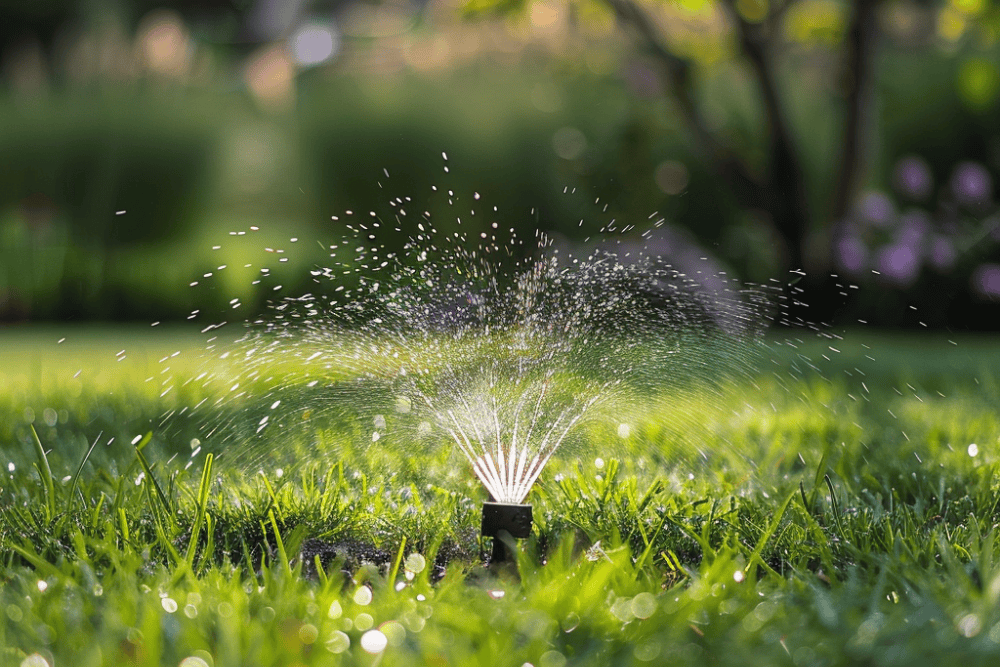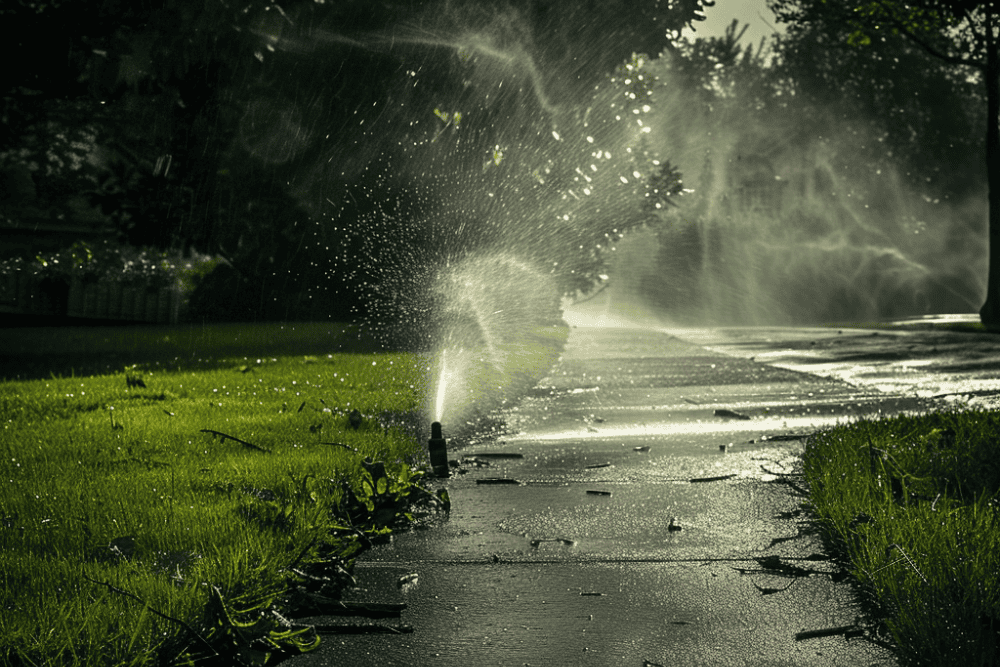Inground Sprinkler System Installation and Repair in Bozeman
Inground sprinkler systems offer an efficient and reliable way to help keep your garden and lawn healthy. These systems are designed for both residential and commercial properties. By using a network of pipes, valves, and sprinkler heads, they deliver water to the desired areas.
A well-designed sprinkler system divides your outdoor space into zones, ensuring each area gets the right amount of water. Depending on the size and layout of your property, the number of zones can vary. Factors such as the type of plants, sun exposure, and soil conditions will play a major role in determining your overall sprinkler system design and layout.

Automated Inground Sprinkler Systems Make it Easy to Give Your Lawn the Water It Needs
Sprinkler heads play a crucial role in controlling water flow and distribution. Different options are available, such as fixed, rotor, and pop-up heads, each with its own advantages. As an example, you can get specialized heads that water in a 360 degree radius, while other heads may have a tighter radius – say 180 degrees or less – to have focused watering in one direction. This can be helpful if your sprinkler heads are placed along edging or fences.
An electronic controller regulates the water valves, determining when to open and close them. This allows for automated and precise watering, saving you time and effort. Many modern sprinkler systems even come equipped with a rain sensor system. This feature prevents water from occurring when the ground is already saturated due to recent rains (when watering really won’t do any good for your lawn).
By choosing the right components and layout, you can optimize your irrigation system for maximum efficiency. Regular maintenance, such as cleaning and adjusting sprinkler heads, will ensure your system continues to perform at its best. Investing in an inground sprinkler system is an essential step in creating a thriving garden and a beautiful landscape with little effort when it comes to meeting water requirements.
Details on the Installation Process
Your sprinkler contractor will work with you to divide your property into logical zones to help based on the water requirements of each area of your property. They’ll determine what types of sprinkler heads (or drip irrigation) make sense in each zone to ensure proper water coverage.
The actual installation of your sprinkler system starts by digging trenches for the underground pipes. Extreme care is taken avoid damaging existing utility lines. The pipes are then laid and connected to a reliable water source.
The sprinkler heads and drip irrigation are then placed in the appropriate locations according to the original design of the zones. Due to differing watering requirements, drip irrigation is generally set up as a dedicated zone that isn’t shared with lawn sprinkler heads.
Control valves are a crucial component of your inground sprinkler system. These will regulate the water flow to each zone, ensuring no area is over or under-watered. Your system should also include a backflow preventer, which keeps water from flowing back into the main supply, reducing contamination risks.
Once everything is in place, everything is connected to a controller. Using your controller, you’re able to set up a schedule and duration for automatic watering for each zone. Each zone can have its own watering days and times based on the requirements of that zone. More shaded zones will usually require less water, zones that see a lot of direct sunlight will require longer watering times.
Maintenance and Repairs
Replacing a Sprinkler Head Takes a Little Doing but Isn’t an All Day Activity
An inground sprinkler system keeps your lawn healthy and lively. Regular maintenance and repairs ensure the system works best. Pets, foot traffic, gunk getting in sprinkler heads, along with normal wear and tear can gradually wear down parts. You’ll want to conduct a regular inspection to look for any potential damage.
A typical problem you may encounter is a damaged sprinkler head that no longer works or that have shifted spray patterns. These sprinkler heads will need to be addressed and possibly replaced. A simpler fix is a damaged nozzle which is relatively easy to replace with a quick trip to your local garden retailer.

Periodically Make Sure That Your Sprinkler Heads are Working and are Aligned Properly So You Don’t End Up Watering the Street Instead of Your Lawn
The result can be sprinkler heads that no longer work or that have shifted spray patterns. These sprinkler heads will need to be addressed and possibly replaced.
Replacing a Sprinkler Head Nozzle is a Relatively Straightforward Process
Winterization is crucial in Bozeman, Montana. You need proper blowout services to avoid water freezing in the pipes. A specialized service ensures the system is ready for harsh weather. Fall blowout prevents damage and costly repairs in the spring.
Frequently Asked Questions
How long does an inground sprinkler system last?
Inground sprinkler systems can last up to 20 years with proper care and maintenance. Regular check-ups, timely repairs, and properly winterizing your system can help extend its lifespan.
How difficult is the installation process?
The installation process can be complex, as it requires knowledge of your landscape, local regulations, and system design. There is a huge learning curve in setting up a sprinkler system (not to mention the back-breaking digging). As with many landscaping projects, the professionals know what you don’t and can get the job done right the first time.
At what depth should sprinkler lines be buried?
Sprinkler lines should be buried at a depth of at least 8-12 inches. While this doesn’t go below the typical frost depth in Bozeman, this should be sufficient to keep the pipes lower than machinery like rototillers. Proper winterization of sprinklers in the fall should prevent any problems from freezing temperatures. This depth also ensures adequate water pressure for your sprinklers while preventing backflow issues.
Are permits required for installation?
It depends on your location. A professional sprinkler contractor can guide you through the permitting process.
What is the average cost of inground sprinkler installation?
The average cost of inground sprinkler installation ranges from $2,500 to $3,500 for a typical residential property. Factors influencing the cost include the size of your lawn, the complexity of the system, and local labor prices. Don’t forget to factor in maintenance and repair costs over time.
What are the Outdoor Watering Restrictions in Bozeman, Montana?
The City of Bozeman has the following water restrictions to promote water conservation that you can find on their website. Note that these rules are likely subject to change based on weather conditions.
Watering using overhead spray irrigation is permissible:
- Even numbered property addresses on Tuesday, Thursday and Saturday before 10am and after 8pm.
- Odd numbered property addresses on Wednesday, Friday and Sunday before 10am and after 8pm.
- Hand watering of trees, plants and gardens is permitted any time
If you live outside of the Bozeman area, be sure to check what watering restrictions exist in your part of the Gallatin Valley.
Sprinkler Systems
Clear Your Property of Excess Debris and Improve Your Curb Appeal

DIY Yard Care
Check out our blog for information on how to do upkeep around your yard. Tips and tricks for keeping your lawn, plants and trees healthy.

Bozeman Events Calendar
A monthly listing of the events for you and your family to enjoy in and around Bozeman

COMPLETE LIST OF ALL SERVICES
All Services
Click a Link Below for More Information About Services Provided
Hardscaping
Curbing
Decks
Fence Maintenance & Install
Fire Pits
Landscape Lighting
Outdoor Kitchens
Patios
Pergolas & Gazebos
Retaining Walls
Walkways
Sprinkler Systems
General
Fall Cleanup-Leaf Removal
Landscape Design
Mulching
Organic Landscaping
Snow Removal
Spring Cleanup
Water Features
Xeriscaping
Trees, Shrubs & Perennials
Flower Beds & Planters
Hedge & Shrub Trimming
Stump Grinding
Tree Planting
Tree Removal
Tree Trimming & Pruning
Lawn Maintenance
Lawn Aeration
Lawn Dethatching
Lawn Edging
Lawn Fertilization
Lawn Mowing
Pest Control
Weed Control
Drainage Issues
Sod & Turf
OUR SERVICE AREA
Serving Bozeman and Surrounding Suburbs
The perfect Bozeman landscaper for your needs.
For more information, click on your community below
LET’S GET STARTED
Contact Us
Bozeman Landscaping Lynx
Phone:
406.709.8320
Email:
operations@bozemanlandscapinglynx.com
Hours:
Sun – Sat: 8am – 6pm